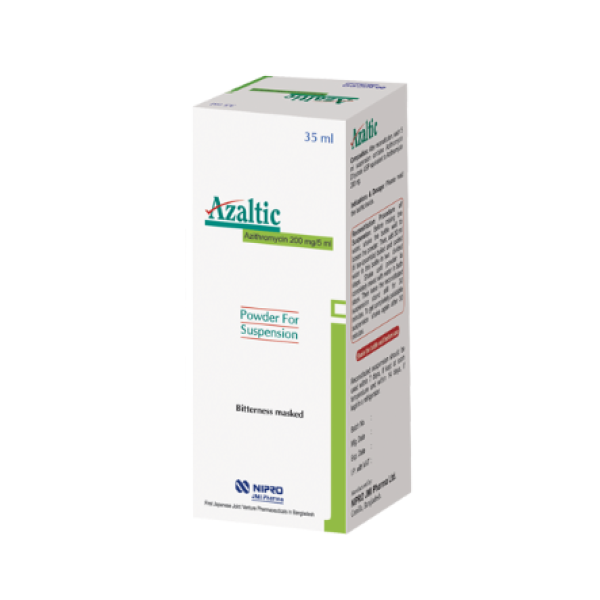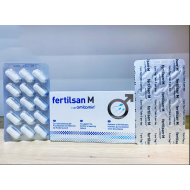
Azaltic 35ml Susp.
Tk130
- Stock: In Stock
- Brand: NIPRO JMI Pharma Ltd.
- Product ID: Azithromycin
0 Pcs sold
3404 Interested
100% Secure Payment

Azaltic 35ml Susp.
Description:
Azaltic (Azithromycin) is an azalide antibiotic, subclass of the macrolide antibiotic, active against both Gram-positive and Gram-negative organisms. Azithromycin acts by binding to the 50S ribosomal subunit of susceptible organisms, thus interferes with the microbial protein synthesis.
ndication
Azaltic (Azithromycin) is indicated for infections caused by susceptible organisms in lower respiratory tract infections including bronchitis and pneumonia, skin and soft tissue infections, otitis media and in upper respiratory tract infections including sinusitis, pharyngitis and tonsillitis. It is also indicated in the treatment of uncomplicated genital infections due to Chlamydia trachomatis & typhoid fever.
Dosage & Administration
Adult : 500 mg once daily orally for 3 days or 500 mg once on day 1, then 250 mg once on days 2-5 for 4 days. For sexually transmitted diseases caused by Chlamydia trachomatis in adults, the dose is 1 gm given as a single dose or 500 mg once on day 1, followed by 250 mg once daily for next 2 days may also be given.
Children : 10 mg/kg body weight once daily for 3 days for child over 6 months or 200 mg (1 teaspoonful) for 3 days if body weight is 15-25 kg; 300 mg (1½ teaspoonfuls) for 3 days if body weight is 26-35 kg; 400 mg (2 teaspoonfuls) for 3 days if body weight is 36-45 kg. In typhoid fever, 500 mg once daily for 7-10 days is given. Azaltic (Azithromycin) should be taken at least 1 hour before or 2 hours after meal.
Children : 10 mg/kg body weight once daily for 3 days for child over 6 months or 200 mg (1 teaspoonful) for 3 days if body weight is 15-25 kg; 300 mg (1½ teaspoonfuls) for 3 days if body weight is 26-35 kg; 400 mg (2 teaspoonfuls) for 3 days if body weight is 36-45 kg. In typhoid fever, 500 mg once daily for 7-10 days is given. Azaltic (Azithromycin) should be taken at least 1 hour before or 2 hours after meal.
Contraindication
Azithromycin is contraindicated in patients with known hypersensitivity to Azithromycin or any other macrolide antibiotics. Azithromycin is contraindicated in patients with hepatic diseases.
Precaution
As with any antibiotic, observation for signs of superinfection with non-susceptible organisms, including fungi, is recommended. Precaution should be taken in patients with more severe renal impairment.
Side Effects
Azithromycin is well tolerated with a low incidence of side effects. The side effects include nausea, vomiting, abdominal discomfort (pain/cramps), flatulence, diarrhoea, headache, dizziness, and skin rashes which are reversible upon discontinuation of therapy.
Drug Interaction
Azithromycin absorption is reduced in presence of food and antacid. In patients receiving ergot alkaloids Azithromycin should be avoided because of the possibility of ergotism resulting from interaction of Azithromycin with the cytochrome P-450 system. Macrolides have been known to increase the plasma concentration of digoxin and cyclosporin. There have been no drug interactions between Azithromycin and Warfarin, Theophylline, Carbamazepine, Methylprednisolone or Cimetidine.
Pregnancy & Lactation
Pregnancy Category of Azithromycin is B. Animal reproduction studies have demonstrated that Azithromycin has no evidence of harm to the fetus. There are no adequate and well controlled studies in pregnant women. Since animal reproduction studies are not always predictive of human response, Azithromycin should be used during pregnancy only if adequate alternatives are not available. It is not known whether Azithromycin is secreted in breast milk. So, caution should be exercised when Azithromycin is administered to nursing women.
Storage Condition
Keep in a dry place away from light and heat. Keep out of the reach of children.
























%20Pvt.%20Ltd./Movicol-Oral-Powder-190x190.jpg)
